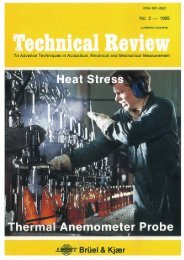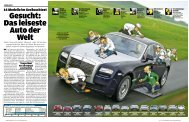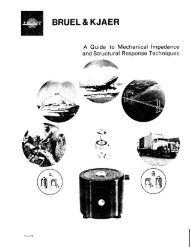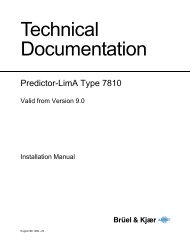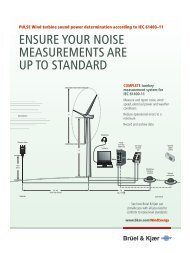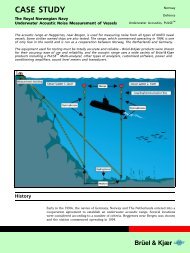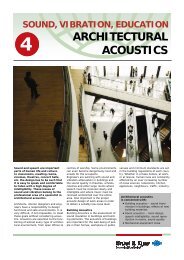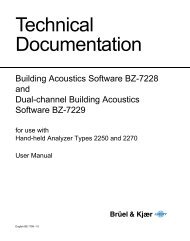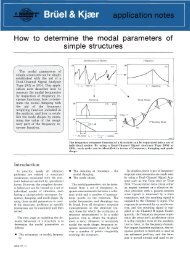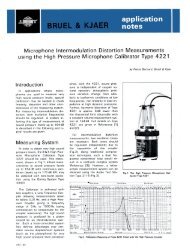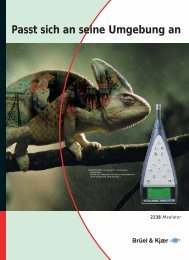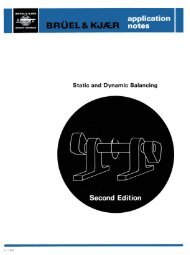A solid foundation for building acoustic measurements
A solid foundation for building acoustic measurements
A solid foundation for building acoustic measurements
Create successful ePaper yourself
Turn your PDF publications into a flip-book with our unique Google optimized e-Paper software.
BRUEL & KJAR<br />
1* ■ 3 nalyzer<br />
r <strong>building</strong> <strong>acoustic</strong> <strong>measurements</strong><br />
Type 4417<br />
se & Vibration Control, November 1981<br />
In recent years, legislati has<br />
been int **ya W v W t y - st of the in-<br />
strialised countries aimed at<br />
protecting the individual from unac-<br />
ceptably high, noise levels inside<br />
buildinas s h a<br />
I I H f*^<br />
sungs, So s<br />
and hospitals. Guide lines have been<br />
established giving<br />
ceptable limits of:<br />
1. Service noise levels<br />
e maximum ac-<br />
2. Reverberation times in stairwells,<br />
gymnasia, auditoria, etc.<br />
3. Airborne and structure borne<br />
insulation<br />
Measurement of these quantities<br />
according to standard procedures is<br />
time-consuming and although legis<br />
lation may exist it might not be<br />
carried out to the letter. In many<br />
is stipulated that every<br />
new dwelling should have its acous<br />
tic qualities measured and rated.<br />
However due to the enormity of this<br />
task, the complicated measurement<br />
procedures and the lack of suitable<br />
instrumentation, concessions are of<br />
ten granted allowing <strong>measurements</strong><br />
to be made on "typical" dwellings in<br />
newly completed housing estates.<br />
This unsatisfactory state of affairs<br />
means that the vast majority of new<br />
dwellings are never investigated and<br />
many dwellings with poor <strong>acoustic</strong><br />
insulation can be labelled as accept<br />
able on the strength of the results<br />
from the "typical" dwelling.<br />
There is, there<strong>for</strong>e, a need <strong>for</strong> in<br />
strumentation which can speed up<br />
routine <strong>measurements</strong> so that the<br />
<strong>acoustic</strong> quality of each and every<br />
new dwelling can be assessed be<br />
<strong>for</strong>e the occupants move in. The<br />
Building Acoustics Analyzer Type<br />
4417 enables such routine measure-<br />
1-043 0018-1A<br />
Fig. 1. The Building Acoustics Analyzer Type 4417<br />
ments to be programmed and<br />
per<strong>for</strong>med completely automatically<br />
in a minimum of time. To measure,<br />
<strong>for</strong> example, the normalised level<br />
difference spectrogram from 100 Hz<br />
to 8 kHz, between two dwellings, in<br />
cluding <strong>measurements</strong> of rever<br />
beration time, background noise and<br />
to print out the results, takes typical<br />
ly about 9 minutes, depending on the<br />
standards being followed.<br />
Building Acoustics Analyzer Type<br />
4417<br />
The Bruel & Kjaer Building Acous<br />
tics Analyzer Type 4417 has been<br />
designed <strong>for</strong> the automatic measure<br />
ment and subsequent calculation of<br />
the common quantities of interest in<br />
<strong>building</strong> <strong>acoustic</strong>s, and <strong>for</strong> precision<br />
sound power <strong>measurements</strong> accord<br />
ing to ISO Standards and<br />
Recommendations. The 4417 is pri<br />
marily intended <strong>for</strong> the control of<br />
sound insulation in new <strong>building</strong>s but<br />
can also be used <strong>for</strong> noise control,<br />
<strong>for</strong> investigations of <strong>building</strong> materi<br />
als, auditoria and concert halls.<br />
Quantities such as reverberation<br />
time, impact and airborne insulation,<br />
sound power, normalised and stan<br />
dardised levels, are determined in 20<br />
third octave bands covering the fre<br />
quency range 100 Hz to 8 kHz<br />
by K. B. Ginn, Bruel & Kjaer<br />
(centre frequency). The results can<br />
be presented digitally on the 4417's<br />
display, graphically via a Level Re<br />
corder Type 2306, printed via an<br />
Alphanumeric Printer Type 2312 or<br />
stored on a Digital Cassette Record<br />
er Type 7400.<br />
The 4417 is a portable (weight<br />
15 lb; 7 kg), battery-powered instru<br />
ment suitable both <strong>for</strong> on site<br />
<strong>measurements</strong> and <strong>for</strong> permanent<br />
laboratory arrangements. All the<br />
controls of the 4417, access to the<br />
battery box and all inputs and out<br />
puts (except the digital output) are<br />
on the front panel which as seen in<br />
Fig.1 resembles that of a pocket cal<br />
culator. Most functions are<br />
push-button controlled and most of<br />
the push-buttons have a second<br />
function.<br />
The 4417 contains a random noise<br />
generator and is capable of produc<br />
ing third octave band limited random<br />
noise so that with a microphone and<br />
a loudspeaker system (or other<br />
sound source or even a vibration ex<br />
citer) the 4417 constitutes a<br />
complete measurement and compu<br />
tational system. When both the two<br />
input channels and the two output<br />
channels are employed, a completely<br />
automatic system <strong>for</strong> measuring in-
sulation and reverberation times is<br />
obtained. The 4417 can retain in its<br />
memory measurement data <strong>for</strong> 3 lev<br />
el-spectra and 1 reverberation-time<br />
spectrum (see Fig.2) even though the<br />
instrument might be switched off and<br />
on again. From these data and the<br />
entered values of the room's volume<br />
and the room's (or wall's) surface<br />
area, the 4417 can calculate any or<br />
all of 9 important spectra (see Fig.3).<br />
Are ISO Building Acoustics Stan<br />
dards Accepted?<br />
The ISO <strong>building</strong> <strong>acoustic</strong>s stan<br />
dards e.g. ISO 140 parts 1 to 8 and<br />
ISO R 717, are not universally ac<br />
cepted verbatim. In many countries<br />
such as Austria, France, Japan,<br />
Netherlands, West Germany, U.S.A,<br />
differences exist between the na<br />
tional and international (ISO)<br />
standards on the methods and ter<br />
minology employed in the<br />
measurement of sound insulation.<br />
The 4417 with its variable averaging<br />
times, decay ranges and frequency<br />
ranges satisfies most needs. Fur<br />
thermore as the 4417 is a<br />
microcomputer based instrument, it<br />
can be reprogrammed at the B & K<br />
factory to fulfil a particular standard<br />
or to incorporate eventual revisions<br />
of existing standards.<br />
Operation of the 4417<br />
To operate the 4417, a microphone<br />
and a loudspeaker (or other sound<br />
source) must be chosen. If two<br />
sound sources are available then<br />
both output channels of the 4417 can<br />
be employed and <strong>for</strong> a chosen mea<br />
surement the 4417 automatically<br />
selects the correct combination of<br />
input and output channel.<br />
For impact sound insulation the<br />
standard Tapping Machine Type<br />
3204 should be used. For noise re<br />
duction investigations, the source<br />
may already be present in the build<br />
ing in the <strong>for</strong>m of a noisy machine.<br />
Spatial and Temporal Averaging<br />
During any measurement, one<br />
must ensure an adequate spatial av<br />
erage of the sound pressure ievel in<br />
the source and/or the receiving<br />
room. There are 3 main methods:<br />
1. Single microphone moved from<br />
position to position<br />
2. Microphone attached to a rotat<br />
2<br />
ing boom<br />
Ch.A <<br />
Source<br />
Room (1)<br />
Receiving<br />
Room (2)<br />
Measurement Symbol<br />
W O V Source Room Level L<br />
Ch.A Ch.A<br />
D<br />
Ch.A Ch.A<br />
Ch. A & B W u<br />
V<br />
V<br />
0 w<br />
Ch.A<br />
O<br />
Ch.A<br />
I 3204 1<br />
| 3204 1<br />
Ch.A<br />
S V<br />
Ch.A Ch. A Ch.B Ch.B<br />
V<br />
Receiving Room Level l_2<br />
Receiving Room Background L.2B<br />
Noise Leve<br />
Reverberation Time T<br />
Impact Level<br />
(Receiving Room Level) L;<br />
Measurement as above<br />
Automatic channel switching<br />
Fig. 2. Measurement capabilities of 4417. For impact <strong>measurements</strong> the standard Tapping<br />
Machine Type 3204 is employed<br />
Level Difference<br />
Impact Level<br />
Sound Power<br />
Calculation Equation<br />
—Standardized<br />
—Normalized<br />
ndex<br />
—Standardized<br />
—Normalized<br />
—Index<br />
3. Array of microphones and a<br />
multiplexer<br />
The method chosen will depend<br />
upon the standard being followed<br />
and the degree of automation<br />
required.<br />
The 4417 controls both the spatial<br />
and temporal averaging during both<br />
D = Li - L<br />
DnT - D + 10 log,<br />
R - D + 10 log10<br />
ia = Insulation Index<br />
L; = L<br />
LnT - Lj — 10 log10<br />
Ln = Li-10log10<br />
L •w<br />
= Impact Index<br />
L2 + 10 log10<br />
T<br />
0 0,5<br />
6,13 S T\<br />
V<br />
T<br />
0,5<br />
61,3 T<br />
V<br />
V +<br />
Fig. 3. Calculation capabilites of the 4417<br />
)<br />
43 S<br />
f - 14<br />
(ISO 140)<br />
(ISO 140)<br />
790792<br />
ISO R 717)<br />
{ISO 140}<br />
(ISO 140}<br />
(ISO R 717)<br />
ISO 3741<br />
&3742<br />
Method 1/<br />
790793/1<br />
level and reverberation measure<br />
ments by controlling the operation of<br />
the boom or of the multiplexer. For<br />
ievel <strong>measurements</strong> there is a choice<br />
of 3 averaging times; 5 s, 16 s or<br />
32 s.<br />
For reverberation <strong>measurements</strong><br />
either 1, 3 or 9 samples can be cho<br />
sen, from which an arithmetic
average of the reverberation time is<br />
calculated.<br />
Spectrum Averaging<br />
The 4417 can average up to 15<br />
spectra <strong>for</strong> each measured quantity.<br />
For the level <strong>measurements</strong> this av<br />
eraging is on an energy basis and <strong>for</strong><br />
the reverberation spectra, a simple<br />
arithmetic averaging. The number of<br />
spectra averaged can be shown in<br />
the display. Levels and reverberation<br />
times can be entered into the 4417<br />
manually so that new data can be<br />
averaged with, <strong>for</strong> example, previ<br />
ous <strong>measurements</strong>.<br />
Selection of Measurement<br />
Four measurement procedures are<br />
available on the 4417;<br />
1. Source Room Level<br />
2. Receiving Room Background<br />
Noise Level<br />
3. Receiving Room Level<br />
4. Receiving Room Reverberation<br />
Time<br />
Any combination of these measure<br />
ments can be programmed to be<br />
per<strong>for</strong>med automatically with the re<br />
sults of the <strong>measurements</strong> printed<br />
out via the Alphanumeric Printer<br />
Type 2312. Measurements 1) to 3)<br />
involve the measurement of the<br />
steady sound pressure level in the<br />
room of interest. The reverberation<br />
measurement, 4), is based on the<br />
monitoring of the decay in sound<br />
pressure from the steady state level.<br />
Reverberation Measurement<br />
The 4417 does not record the de<br />
cay in sound pressure in any fashion<br />
but directly measures the decay time<br />
between two chosen levels. The up<br />
per level is fixed at -5 dB and the<br />
lower level may be chosen to be<br />
-25 dB, -35dB or -45 dB. The time<br />
required <strong>for</strong> the sound pressure level<br />
to decay between these two levels is<br />
taken as the summation of all the<br />
intervals during which the level actu<br />
ally lies between these two levels.<br />
The 4417 then calculates the rever<br />
beration time to yield directly a<br />
result in seconds.<br />
Noise Generator and Output Filters<br />
When a measurement is started,<br />
the noise generator within the 4417<br />
emits a wide band pink noise which<br />
passes through a series of 20 third<br />
octave filters covering the frequency<br />
range 100 Hz to 8 kHz. These filters<br />
comply with IEC 225-1966, DIN<br />
45 652 and ANSI S1.11-1966. The<br />
third octave limited random noise is<br />
then time gated to produce a signal<br />
burst. For level <strong>measurements</strong> this<br />
burst has a duration corresponding<br />
to the chosen averaging time (i.e. ei<br />
ther 5 or 16 or 32 seconds). For<br />
reverberation time <strong>measurements</strong><br />
the burst is of approximately 8 sec<br />
onds duration at 100 Hz and less at<br />
higher frequencies to reduce the<br />
measurement time.<br />
Frequency Sweeping<br />
The 4417 per<strong>for</strong>ms the selected<br />
<strong>measurements</strong> as it sweeps through<br />
the third octave frequency bands up<br />
to 8 kHz. Any one frequency band<br />
can be chosen as the initial band. If<br />
desired, the sweep can be terminat<br />
ed after the 3,15 kHz band, the<br />
frequency range 100 Hz to 3,15 kHz<br />
being the most widely used in build<br />
ing <strong>acoustic</strong>s. Measurements can<br />
also be made at a single frequency<br />
band e.g. when the 4417 indicates<br />
that an error has occurred and the<br />
measurement at that particular fre<br />
quency should be repeated.<br />
Detector<br />
For the first couple of seconds of<br />
each measurement the 4417 "lis<br />
tens" to the noise and optimises the<br />
gain of the input amplifiers to the<br />
expected noise level. A clever fea<br />
ture of the 4417 is that it is also<br />
programmed to give error codes if<br />
the expected level is not measured<br />
during the chosen averaging time<br />
(e.g. a sudden increase in back<br />
ground noise due to a passing<br />
vehicle). For reverberation measure<br />
ments the detector determines the<br />
sound pressure level from the root<br />
mean square (rms) value of the sig<br />
nal. For level <strong>measurements</strong>, it is the<br />
equivalent continuous sound level,<br />
Leq, which is measured i.e. an inte<br />
gration on an energy basis of the<br />
instantaneous <strong>acoustic</strong> pressure<br />
over the selected averaging time (i.e.<br />
5 s, 16 s or 32 s). The measured<br />
spectra are then stored within the<br />
4417 ready <strong>for</strong> display or <strong>for</strong> use in<br />
the calculation of one or more of the<br />
quantities listed in Fig.3.<br />
Calculation<br />
in the list of the calculation capa-<br />
bilites of the 4417 (Fig.3), the term<br />
"Standardised" in a name means<br />
that the quantity has been corrected<br />
<strong>for</strong> the reverberation time in the re<br />
ceiving room with respect to a<br />
standard reverberation time of 0,5 s.<br />
The term "Normalised" means that a<br />
correction has been made to ac<br />
count <strong>for</strong> the receiving room's<br />
absorption. Apart from the Standar<br />
dised Level Difference and the<br />
Standardised Impact Level, the 4417<br />
needs to be provided with a value <strong>for</strong><br />
the volume, V, of the receiving room<br />
and a value <strong>for</strong> the surface area, S,<br />
(either of the <strong>building</strong> element under<br />
test or of the total surface area in the<br />
receiving room) in order to per<strong>for</strong>m<br />
the calculations. V and S values are<br />
entered into the memory by means<br />
of the frequency-band push-buttons,<br />
which have a second function as<br />
keys <strong>for</strong> the digits 0, 1, 2 up to 9.<br />
By push-button selection, any of the<br />
quantities in Fig.3 can now be calcu<br />
lated, displayed and stored in the<br />
memory to await recall or output.<br />
Other features<br />
A number of "extras" have been<br />
programmed into the 4417 such as<br />
error code detection and numerous<br />
self test routines. Errors in the mea<br />
surement or the calculation are cod<br />
ed and displayed by the 4417 and are<br />
also indicated in the printer and level<br />
recorder outputs. Manually entered<br />
data are tabbed with a question<br />
mark to indicate that these data<br />
were not, in fact, measured.<br />
Some measurement results<br />
Fig.4 shows some measurement<br />
results as read out via the Level Re<br />
corder Type 2306. The upper<br />
spectrogram shows the high level of<br />
background noise which was present<br />
in a large hall of a power plant where<br />
reverberation <strong>measurements</strong> had to<br />
be made. The middle spectrogram<br />
shows error codes at the 100 Hz,<br />
125 Hz and 200 Hz third-octave<br />
bands indicating that background<br />
noise was too high <strong>for</strong> reverberation<br />
<strong>measurements</strong> to be per<strong>for</strong>med over<br />
a decay range of 20 dB.<br />
The lower spectrogram shows the<br />
normalised level differences and<br />
their calculated sound insulation in<br />
dices as measured across two party<br />
walls in a newly constructed block of<br />
flats. The <strong>measurements</strong> on one wall<br />
were expected to be made whereas<br />
no <strong>measurements</strong> were expected on<br />
the other wall. The difference in the<br />
quality of the workmanship pro<br />
duced by a <strong>for</strong>ewarning of control<br />
<strong>measurements</strong> is evident. Fig.5
shows a typical arrangement <strong>for</strong> in<br />
situ <strong>measurements</strong>.<br />
Good sound insulation depends on<br />
careful construction<br />
The Danish Institute <strong>for</strong> Building<br />
Research have concluded that con<br />
trol <strong>measurements</strong> of sound<br />
insulation in raw, new <strong>building</strong>s can<br />
improve the sound insulation of the<br />
finished <strong>building</strong> by enabling "leaks"<br />
such as missing mortar between<br />
brickwork and joints, to be found<br />
and repaired at an early stage. Pub<br />
lished results (reference<br />
"Lydisolation i betonbyggeri", Sta-<br />
tens Bygge<strong>for</strong>skningsinstitute<br />
Report 101, 1977, Postbox 119, 2970<br />
Horsholm, Denmark) show that in<br />
most <strong>building</strong>s it is possible to ob<br />
tain improvements in the insulation<br />
index of from 1 dB to 3 dB and in<br />
some cases as much as 5 dB<br />
Conclusions<br />
Building <strong>acoustic</strong> standards have<br />
an important characteristic in com<br />
mon - they are not simple! In the<br />
debate on the simplification of the<br />
measurement technique two camps<br />
have become established, divided on<br />
the manner in which insulation<br />
should be measured in situ. The sup<br />
porters of the "classical" method<br />
say that the in<strong>for</strong>mation contained in<br />
a sound reduction index spectro<br />
gram cannot be compressed into a<br />
single figure index and that a longer<br />
measurement time is a small price to<br />
pay <strong>for</strong> all the extra in<strong>for</strong>mation. The<br />
opposing camp advocates the use of<br />
a rapid test method (such as that<br />
proposed in the tentative recom<br />
mended practice of ASTM E 597-77<br />
T). This method should yield a single<br />
figure index whose measurement<br />
should require no more than a cou<br />
ple of minutes and should be a good<br />
indication of the "subjective accept<br />
ability" (reference "Moves towards<br />
simplification of methods <strong>for</strong> the<br />
measurement of airborne sound in<br />
sulation" by H. G. Leventhall, Noise<br />
and Vibration Bulletin 1979, pp. 164-<br />
168). Where good insulation is indi<br />
cated no more <strong>measurements</strong> need<br />
E<br />
aaaaaaooaaDaooaaaoDaoDaananaDaooannaaaoaaaDnonaaoo<br />
Briiel & Kjser Potentiometer Range: 50 dB Rectifier: Lower Lim. Freq.: Hz Wr. Speed: mm/sec. Paper Speed: mm/sec.<br />
Measuring Obj. dB dB<br />
H.C. 0rsted 40 :20<br />
Power<br />
Station<br />
301-15<br />
Block 7<br />
Background<br />
noise<br />
Rec. No.: 1 1Q<br />
Date:3-2-81_<br />
Sign:LSC<br />
QP 0124<br />
50r25 70dB ■ ■ ■ ■ ■ « . ■ ! ■ ■ ! ■ ■ ■ ■ ■ ■ ■ ■ !■■■■!■ ■ ■ ■ ■ ■ ■ ■ ! ■ . ■ ■ ! ■ ■ ■ ■ ■ ■ ■ ■ ■ ■ ■ i10n<br />
20H0<br />
20dB<br />
1u 20 H7 50<br />
Multiply Freq. Scale by<br />
10Q 200 Hz 500 1000<br />
_____ Zero Level:<br />
2000 Hz 5000 10000 20000 40000 D A B C Lin.<br />
(1612/2112) A B C Lin. 810232<br />
fl<br />
naaaacDnaDaDDDannaDDnnnDcaaaDaDaoaaaaaDDnaaaDaaDaD<br />
Briiel & Kjser Potentiometer Range:<br />
50r25r10STT<br />
dB Rectifier: Lower Lim. Freq.: Hz Wr. Speed: mm/sec. Paper Speed:. mm/sec.<br />
Measuring Obj. ,.<br />
dBLdB<br />
H.C. 0rsteds4Ou2O<br />
Power<br />
Station<br />
30-15<br />
Block 7<br />
Dimensions<br />
24x57x16m?0-lQ<br />
V - 22000 m 3 :<br />
Rec. No.:_] 10- r<br />
Date: 3-2-81 _ t<br />
Sign: LSC<br />
QP 0124<br />
0- 0<br />
10 20 Hz 50<br />
Multiply Freq. Scale by<br />
100 200 Hz 500 1000<br />
. Zero Level:<br />
2000 Hz 5000 10000 20000 40000 DA B C Lin.<br />
(1612/2112) A B C Lin. 810231<br />
1<br />
nDaaaaoDaDoaaDaaoDacDDaaDaDCDDD3onanaaaoaaDapana~D<br />
Briiel & Kjaer Potentiometer Range: 3U dB Rectifier: Lower Lim. Freq.:_ _Hz Wr. Speed: _ _ mm/sec. Paper Speed: mm/sec.<br />
50 r25r—170—f ■ p f 1 |1 | f<br />
Mo^uring Obj.<br />
I, meas. d8 .dB<br />
expected 40^20<br />
and unexpected:<br />
to be per<strong>for</strong>med<br />
in raw<br />
dwellings <strong>for</strong><br />
150 mm<br />
concrete wa!<br />
Rec. Ho<br />
Date:<br />
Sign:<br />
QP 0124<br />
^J^J<br />
20 -10<br />
10- 5<br />
o:o<br />
10 20 Hz 50<br />
Multiply Freq. Scale by<br />
100 200 Hz 500 1000<br />
Zero Level:<br />
2000 Hz 5000<br />
1000C 20000 40000 D A B C Lin.<br />
0- 0<br />
(1612/2112) A B C Lin. 801185<br />
Fig. 4. Some measurement results. The upper and middle spectrograms were measured in a<br />
power station and the lower spectrogram in a newly constructed block of flats<br />
be per<strong>for</strong>med. In the borderline<br />
cases, however, the "classical"<br />
measurement needs to be made to<br />
determine whether the insulation is<br />
acceptable or not. In the case of<br />
poor insulation, a "classical" mea<br />
surement might help to determining<br />
how best to improve the fault. A rap<br />
id test method there<strong>for</strong>e would not<br />
replace but rather supplement the<br />
"classical" measurement.<br />
The Building Acoustics Analyzer<br />
Type 4417 goes a long way towards<br />
solving the dilemma of rapid versus<br />
"classical" testing; the 4417 per<br />
<strong>for</strong>ms the "classical" <strong>measurements</strong><br />
and calculations rapidly and is there<br />
<strong>for</strong>e eminently suitable <strong>for</strong> both the<br />
quick "acceptable/not acceptable"<br />
testing and <strong>for</strong> the more detailed<br />
analysis required in special cases.<br />
A _. i A l l ^ H r T l iWfl 4 4 4 4 *W 4 4 4 4^ iWC'l 4 L \ 4.4. L<br />
' '//A 4^^ T '4*4 4 4^^^^ T 4*4*4 4 4^^^ T 4*4*4^i^^^4 , 4*4—r4j^^^4'<br />
I 4 4 4*4*4*^4*4 4 4 iVOffl 4 4 4 4*4*4*4 4*\\ \ \ \ + 4* 4 / * \ \ L . » M V I (<br />
T** 4^" " " "4*4 rty m fff* 4^" " "4- 4~4^^^ T 'f f+\^^^^*f f fT\^<br />
Bruel & Kjaer Instruments, Inc.<br />
185 Forest Street, Marlborough, Massachusetts 01752/(617) 481-7000 TWX 710/347-1187<br />
Fig. 5. Typical instrumentation controlled by<br />
the 4417 used <strong>for</strong> in situ <strong>measurements</strong>.<br />
The arrangement shown here<br />
yields the results in printed and in<br />
graphical <strong>for</strong>m<br />
Printed in Denmark by Nasrum Offset



